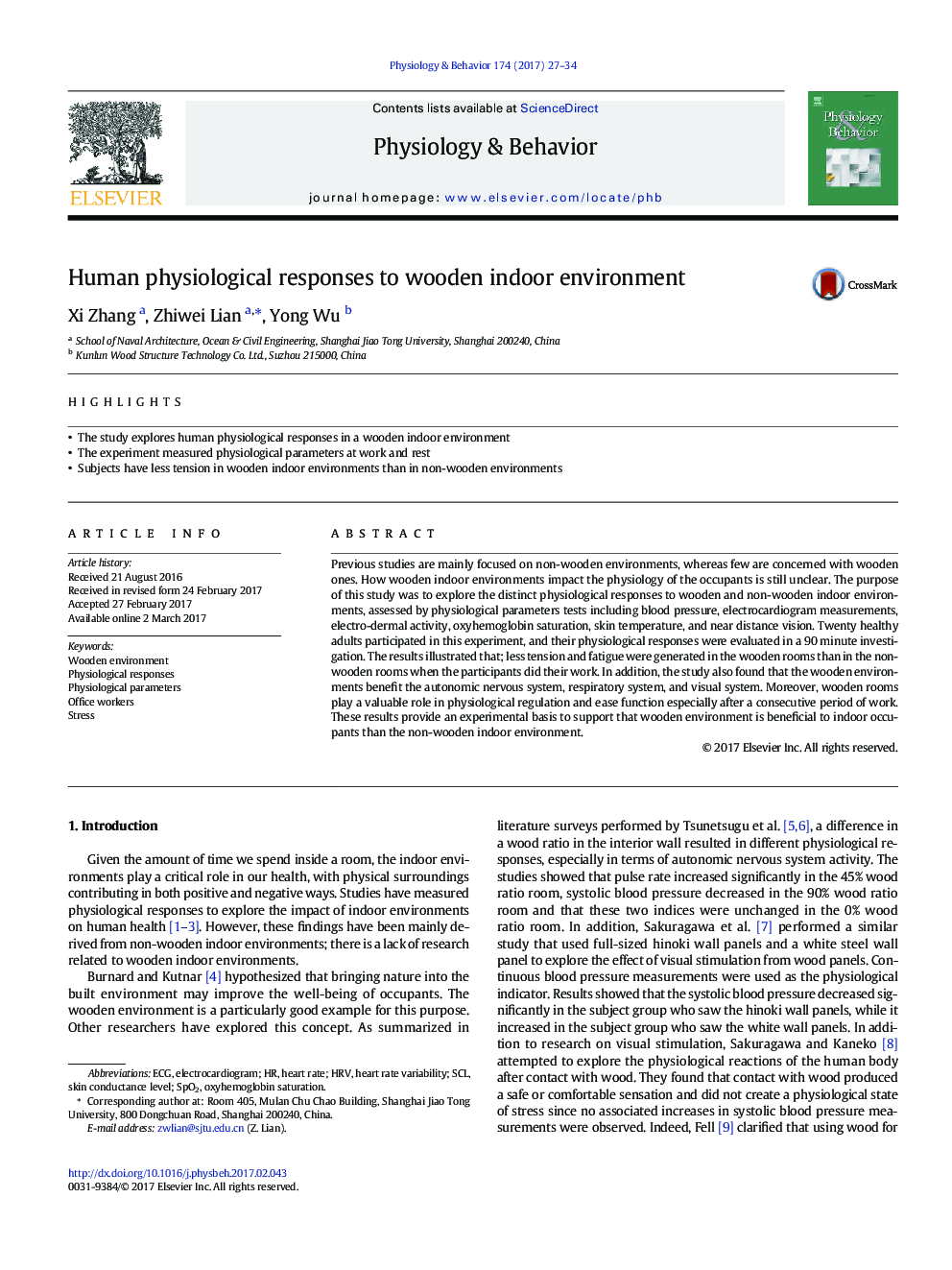| کد مقاله | کد نشریه | سال انتشار | مقاله انگلیسی | نسخه تمام متن |
|---|---|---|---|---|
| 5593693 | 1571145 | 2017 | 8 صفحه PDF | دانلود رایگان |
عنوان انگلیسی مقاله ISI
Human physiological responses to wooden indoor environment
ترجمه فارسی عنوان
پاسخ های فیزیولوژیکی انسان به محیط داخلی چوبی
دانلود مقاله + سفارش ترجمه
دانلود مقاله ISI انگلیسی
رایگان برای ایرانیان
کلمات کلیدی
SpO2SCLHRV - ENGStress - استرس یا فشار روانیOxyhemoglobin saturation - اشباع OxyhemoglobinECG - الکتروکاردیوگرام یا نوار قلبelectrocardiogram - الکتروکاردیوگرام یا نوار قلبskin conductance level - سطح هدایت پوستHeart rate - ضربان قلبheart rate variability - نوسان ضربان قلبPhysiological parameters - پارامترهای فیزیولوژیکیPhysiological responses - پاسخ های فیزیولوژیکیOffice workers - کارمندان اداره
ترجمه چکیده
مطالعات قبلی عمدتا بر روی محیط های غیر چوبی انجام می شود، در حالی که تعداد کمی از آن ها مربوط به چوب های چوبی است. چگونه محیط داخلی چوبی بر فیزیولوژی اشخاص تاثیر می گذارد هنوز مشخص نیست. هدف از این مطالعه بررسی واکنش های فیزیولوژیکی متفاوتی به محیط های چوبی و غیر چوبی بوده و با استفاده از آزمون های پارامترهای فیزیولوژیکی از جمله فشار خون، اندازه گیری الکتروکاردیوگرام، فعالیت الکتریکی پوست، اشباع اکسی هموگلوبین، درجه حرارت پوست و نزدیکی فاصله بینایی بررسی شده است. 20 فرد سالم در این آزمایش شرکت کردند و پاسخ های فیزیولوژیکی آنها در یک مطالعه 90 دقیقه ای بررسی شد. نتایج نشان داد که؛ زمانی که شرکت کنندگان کار خود را انجام دادند، تنش و خستگی کمتر در اتاق های چوبی ایجاد شد تا از اتاق های غیر چوبی. علاوه بر این، مطالعه نیز دریافت که محیط های چوبی به نفوذ سیستم عصبی، سیستم تنفسی و سیستم دیداری سود می رسانند. علاوه بر این، اتاق های چوبی نقش مهمی در تنظیمات فیزیولوژیکی و عملکرد سهولت دارند به ویژه پس از یک دوره متوالی کار. این نتایج ارائه یک مبحث تجربی برای حمایت از محیط زیست چوبی برای ساکنین داخلی در مقایسه با محیط داخلی غیر چوبی است.
موضوعات مرتبط
علوم زیستی و بیوفناوری
بیوشیمی، ژنتیک و زیست شناسی مولکولی
فیزیولوژی
چکیده انگلیسی
Previous studies are mainly focused on non-wooden environments, whereas few are concerned with wooden ones. How wooden indoor environments impact the physiology of the occupants is still unclear. The purpose of this study was to explore the distinct physiological responses to wooden and non-wooden indoor environments, assessed by physiological parameters tests including blood pressure, electrocardiogram measurements, electro-dermal activity, oxyhemoglobin saturation, skin temperature, and near distance vision. Twenty healthy adults participated in this experiment, and their physiological responses were evaluated in a 90Â minute investigation. The results illustrated that; less tension and fatigue were generated in the wooden rooms than in the non-wooden rooms when the participants did their work. In addition, the study also found that the wooden environments benefit the autonomic nervous system, respiratory system, and visual system. Moreover, wooden rooms play a valuable role in physiological regulation and ease function especially after a consecutive period of work. These results provide an experimental basis to support that wooden environment is beneficial to indoor occupants than the non-wooden indoor environment.
ناشر
Database: Elsevier - ScienceDirect (ساینس دایرکت)
Journal: Physiology & Behavior - Volume 174, 15 May 2017, Pages 27-34
Journal: Physiology & Behavior - Volume 174, 15 May 2017, Pages 27-34
نویسندگان
Xi Zhang, Zhiwei Lian, Yong Wu,
